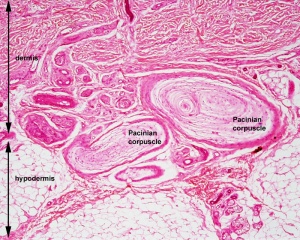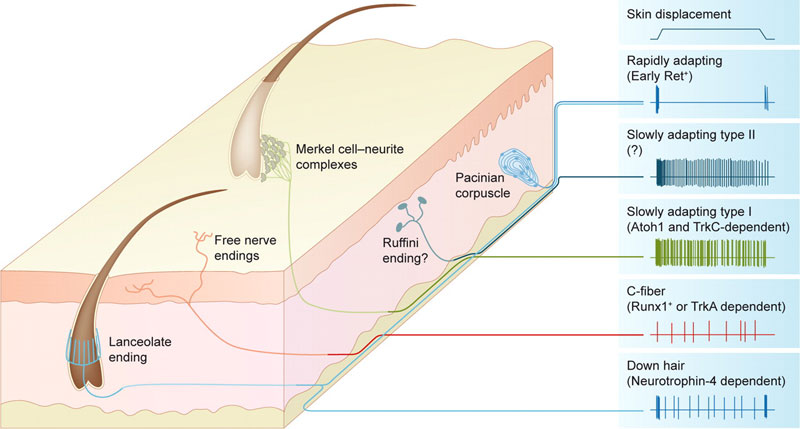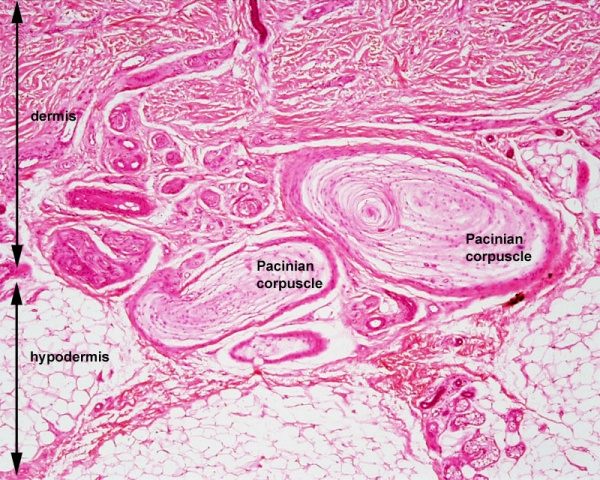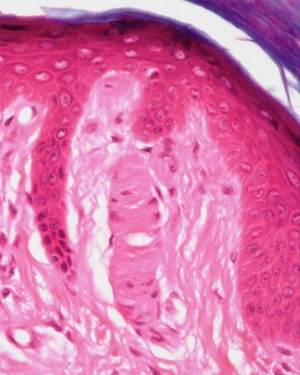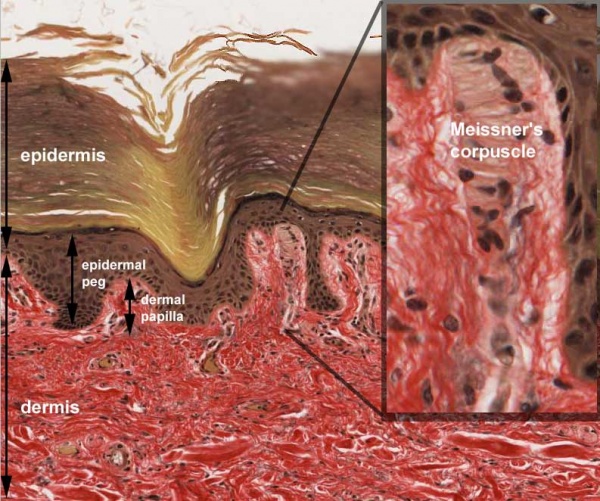Sensory - Touch Development: Difference between revisions
mNo edit summary |
mNo edit summary |
||
| Line 9: | Line 9: | ||
{{Integumentary Links}} | |||
{{Senses Links}} | |||
== Some Recent Findings == | == Some Recent Findings == | ||
{| | {| | ||
| Line 21: | Line 21: | ||
*''' Identification of epidermal progenitors for the Merkel cell lineage'''<ref><pubmed>21041368</pubmed></ref> "Epithelial stem cells in adult mammalian skin are known to maintain epidermal, follicular and sebaceous lineages during homeostasis. Recently, Merkel cell mechanoreceptors were identified as a fourth lineage derived from the proliferative layer of murine skin epithelium; however, the location of the stem or progenitor population for Merkel cells remains unknown. Here, we have identified a previously undescribed population of epidermal progenitors that reside in the touch domes of hairy skin, termed touch dome progenitor cells (TDPCs)." | *''' Identification of epidermal progenitors for the Merkel cell lineage'''<ref><pubmed>21041368</pubmed></ref> "Epithelial stem cells in adult mammalian skin are known to maintain epidermal, follicular and sebaceous lineages during homeostasis. Recently, Merkel cell mechanoreceptors were identified as a fourth lineage derived from the proliferative layer of murine skin epithelium; however, the location of the stem or progenitor population for Merkel cells remains unknown. Here, we have identified a previously undescribed population of epidermal progenitors that reside in the touch domes of hairy skin, termed touch dome progenitor cells (TDPCs)." | ||
|} | |} | ||
{| class="wikitable collapsible collapsed" | |||
! More recent papers | |||
|- | |||
| [[File:Mark_Hill.jpg|90px|left]] {{Most_Recent_Refs}} | |||
Search term: [http://www.ncbi.nlm.nih.gov/pubmed/?term=Touch+Development ''Touch Development''] | |||
<pubmed limit=5>Touch Development</pubmed> | |||
|} | |||
==Touch Receptors== | ==Touch Receptors== | ||
| Line 96: | Line 104: | ||
==External Links== | ==External Links== | ||
{{External Links}} | |||
==Terms== | ==Terms== | ||
| Line 105: | Line 113: | ||
{{ | {{Glossary}} | ||
{{ | {{Footer}} | ||
[[Category:Senses]] [[Category:Touch]] | [[Category:Senses]] [[Category:Touch]] | ||
Revision as of 10:44, 18 May 2014
| Embryology - 17 May 2024 |
|---|
| Google Translate - select your language from the list shown below (this will open a new external page) |
|
العربية | català | 中文 | 中國傳統的 | français | Deutsche | עִברִית | हिंदी | bahasa Indonesia | italiano | 日本語 | 한국어 | မြန်မာ | Pilipino | Polskie | português | ਪੰਜਾਬੀ ਦੇ | Română | русский | Español | Swahili | Svensk | ไทย | Türkçe | اردو | ייִדיש | Tiếng Việt These external translations are automated and may not be accurate. (More? About Translations) |
Introduction
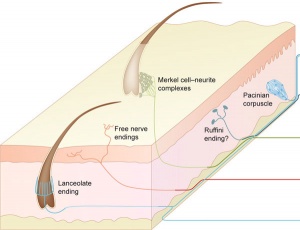
These notes introduce the development of the sense of touch, part of the somatosensory system. Because of the distribution of the sensory structures within the skin, this topic is generally also covered in integumentary development.
| Senses Links: Introduction | placode | Hearing and Balance hearing | balance | vision | smell | taste | touch | Stage 22 | Category:Sensory |
Some Recent Findings
|
| More recent papers |
|---|
|
This table allows an automated computer search of the external PubMed database using the listed "Search term" text link.
More? References | Discussion Page | Journal Searches | 2019 References | 2020 References Search term: Touch Development <pubmed limit=5>Touch Development</pubmed> |
Touch Receptors
Touch receptors in mammalian skin and the neural encoding of reception.[5]
Touch Pathway
Pacinian corpuscle
Meissner's corpuscle
Merkel cell
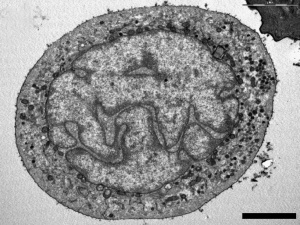
Isolated Merkel cell (em) |
Merkel cell (Merkel-Ranvier cell) integumentary (skin) receptor cell connected with somatosensory afferents.
Cell characteristics a polylobulated nucleus and numerous typical dense-core granules in a clear cytoplasm. Scale bar 5 µm (Stain - Osmium) |
Sensory Modalities
Thermoreceptors
- Receptors for heat (warmth) and cold (chill) detection.
- heat - C-fibres
- cold - Aδ fibres
Nociceptors
- Receptors for encoding and processing noxious stimuli.
- A-δ nociceptors
- Polymodal C-nociceptors
- C- mechano-insensitive nociceptors
Abnormalities
Merkel cell carcinoma
References
- ↑ <pubmed>20956378</pubmed>| PMC2958478 | JCB
- ↑ <pubmed>22710006</pubmed>
- ↑ <pubmed>21906948</pubmed>
- ↑ <pubmed>21041368</pubmed>
- ↑ <pubmed>20956378</pubmed>| PMC2958478 | JCB
Reviews
<pubmed>21841076</pubmed> <pubmed>20956378</pubmed>| JCB
Articles
Books
Neurobiology of Sensation and Reward. Gottfried JA, editor. Boca Raton (FL): CRC Press; 2011. Chapter 7 - Touch PMID 22593916
Search PubMed
Search Pubmed: Touch Development | touch receptors |
External Links
External Links Notice - The dynamic nature of the internet may mean that some of these listed links may no longer function. If the link no longer works search the web with the link text or name. Links to any external commercial sites are provided for information purposes only and should never be considered an endorsement. UNSW Embryology is provided as an educational resource with no clinical information or commercial affiliation.
Terms
- Georg Meissner - (1829-1905) German histologist, physiologist and anatomist. Beiträge zur Anatomie und Physiologie der Haut. (Contributions to the anatomy and physiology of the skin.) Leipzig, 1853.
- Filippo Pacini - (1812-1883) Italian anatomist, published in 1840, and the name "Pacini's corpuscles" was proposed in 1844 by Henle and also by Kölliker.
Glossary Links
- Glossary: A | B | C | D | E | F | G | H | I | J | K | L | M | N | O | P | Q | R | S | T | U | V | W | X | Y | Z | Numbers | Symbols | Term Link
Cite this page: Hill, M.A. (2024, May 17) Embryology Sensory - Touch Development. Retrieved from https://embryology.med.unsw.edu.au/embryology/index.php/Sensory_-_Touch_Development
- © Dr Mark Hill 2024, UNSW Embryology ISBN: 978 0 7334 2609 4 - UNSW CRICOS Provider Code No. 00098G
